| Reviews & Columns |
|
Reviews DVD TV on DVD Blu-ray 4K UHD International DVDs In Theaters Reviews by Studio Video Games Features Collector Series DVDs Easter Egg Database Interviews DVD Talk Radio Feature Articles Columns Anime Talk DVD Savant Horror DVDs The M.O.D. Squad Art House HD Talk Silent DVD
|
DVD Talk Forum |
|
|
| Resources |
|
DVD Price Search Customer Service #'s RCE Info Links |
|
Columns
|
|
|
Planet of the Apes - The Ultimate DVD Collection - With Ape Head Packaging
In 1963, ace Hollywood publicist Arthur P. Jacobs acquired a pre-release copy of Pierre Boulle's latest novel, La Planète des Singes. While Boulle did not consider the story to be among his finest works, and Jacobs had yet to actually produce a motion picture, the up-and-coming producer nonetheless convinced his friend, Twentieth Century Fox's Richard Zanuck, to option the rights to the story and give him the go-ahead to pursue it. Years went by as Jacobs faced one obstacle after another, painstakingly piecing together the necessary ingredients and utilizing his numerous public relations contacts to generate interest in the project and fend off constant studio indifference and rejection. Even after a makeup test financed by the studio proved the viability of talking apes on screen, Fox still walked away from the project, stating that while they were pleased with the results, it just wouldn't be worth the investment. It wasn't until Fantastic Voyage opened to hugely successful numbers later that year that Fox ultimately greenlit the film for release in February of 1968, nearly 5 years after the journey began.
The struggle to turn Boulle's novel into a major motion picture proved worth it, as Planet of the Apes would not only become a successful motion picture on its own and a revered science fiction classic, but it would inspire a cultural phenomenon the likes of which had never been seen before. The precursor to mega-franchise fandom like Star Trek and Star Wars, Apes hysteria was everywhere, and from 1970 to 1975 a new entry in the franchise was presented to the public each year in the forms of 4 theatrical sequels and 2 television series. While most of this material has already been released on DVD in one form or another, Fox Home Entertainment now groups it all together in a staggering 14-disc "Ultimate DVD Collection" presented in a limited edition lifelike bust of Roddy McDowall's television character of Caesar.
N.B.: While it is highly unlikely that readers do not already know the secrets to these films, I will try to keep major revelations to a minimum, only directly referencing each film's ending in its sequel's review.
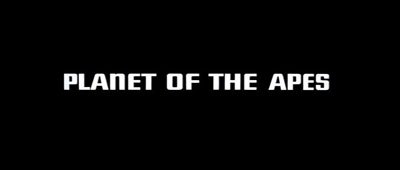

The original. The classic. Planet of the Apes tells the story of American astronaut George Taylor (Charlton Heston), the leader of a four-person crew on a journey through deep space to test "Dr. Hasslein's Theory of Time" (essentially Einstein's Theory of Special Relativity). By hurtling through the cosmos at nearly the speed of light, it is theorized that the Earth will age hundreds of years in what will appear to be merely months by the members of the crew. Something goes horribly wrong, however, while the crew snoozes away the months in suspended animation, and the ship crash-lands on a mysterious alien planet where mankind does not sit atop the evolutionary ladder. On this world, talking apes are in charge, enslaving humanity within their primitive society and hunting the mute savages for sport. As his crew are picked off one by one, Taylor soon finds himself alone in this upside down madhouse, forced to prove his value to his ape captors before they perform damaging experiments to his "mutant" brain.
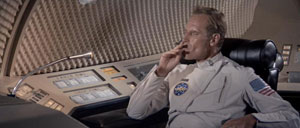 The first to notice Taylor's uniqueness among the humans is Zira (Kim Hunter), a chimpanzee scientist, who is intrigued by what she believes to be an advanced level of ape mimicry ("human see, human do"). When Taylor demonstrates his ability to communicate through written word, however, she realizes that there is something very special about this creature and consults her husband Cornelius (Roddy McDowall) for advice about what to do. Zira is a bold free-thinker who seeks knowledge for the sake of advancing ape culture, but Cornelius has been burned by this mentality in the past, admonished by his superiors for venturing into the "Forbidden Zone" to study the true history of ape evolution. He warns her that further investigation of this seemingly intelligent human could be considered heresy against the "Sacred Scrolls", and this exchange introduces one of the many sociopolitical themes addressed by the film.
The first to notice Taylor's uniqueness among the humans is Zira (Kim Hunter), a chimpanzee scientist, who is intrigued by what she believes to be an advanced level of ape mimicry ("human see, human do"). When Taylor demonstrates his ability to communicate through written word, however, she realizes that there is something very special about this creature and consults her husband Cornelius (Roddy McDowall) for advice about what to do. Zira is a bold free-thinker who seeks knowledge for the sake of advancing ape culture, but Cornelius has been burned by this mentality in the past, admonished by his superiors for venturing into the "Forbidden Zone" to study the true history of ape evolution. He warns her that further investigation of this seemingly intelligent human could be considered heresy against the "Sacred Scrolls", and this exchange introduces one of the many sociopolitical themes addressed by the film.
Their superior, the orangutan Dr. Zaius (Maurice Evans), holds the title "Minister of Science and Chief Defender of the Faith", a conflict of interest to be sure. He is charged with defending the religious beliefs of the community and also holds power over what knowledge is allowed to be known, and Taylor's existence challenges everything he is sworn to protect. At first slowly and then more forcefully, he tries to prevent the chimpanzee scientists from learning too much about this human. He expresses his favor for experimental brain surgery in this case, but he draws the line at the behavioral studies Zira is conducting, noting that the creatures are a nuisance to be exterminated. Still, for all his insistence, he cannot adequately account for Taylor. The stranger speaks, writes, and possesses knowledge unlike any human they have encountered.
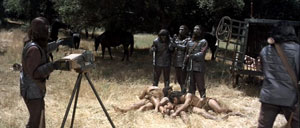 It is this philosophical battle between the knowledge-seeking chimpanzees and their stone-walling orangutan superior that makes up the heart of the film; and as with all great science fiction, their interactions hold up a mirror to our own society, sometimes with subtle jabs and sometimes openly mocking our flaws as humans. Particularly note-worthy is a tribunal where Taylor stands trial before a council of three orangutans for the crime of ... existing. Zira and Cornelius themselves are on thin ice for acknowledging that this human is more than meets the eye and seeking to learn more about him.
It is this philosophical battle between the knowledge-seeking chimpanzees and their stone-walling orangutan superior that makes up the heart of the film; and as with all great science fiction, their interactions hold up a mirror to our own society, sometimes with subtle jabs and sometimes openly mocking our flaws as humans. Particularly note-worthy is a tribunal where Taylor stands trial before a council of three orangutans for the crime of ... existing. Zira and Cornelius themselves are on thin ice for acknowledging that this human is more than meets the eye and seeking to learn more about him.
Early in the story, it seems as though Zaius is merely a stubborn zealot, denying what is in front of him while clinging to the "truth" he chooses to believe. However, as the film progresses, we find that he has much more interesting motives for opposing Zira and Cornelius's claim that man has worth beyond that of an enslaved race of mutes. Zaius is the keeper of a greater truth, that humanity once was more evolved than they currently are, but they were a destructive force warned about in the Sacred Scrolls: "Beware the beast Man, for he is the Devil's pawn. Alone among God's primates, he kills for sport or lust or greed. Yea, he will murder his brother to possess his brother's land. Let him not breed in great numbers, for he will make a desert of his home and yours. Shun him, for he is the harbinger of death." As Zaius's greater purpose is revealed, the film takes on a greater depth of meaning.
Boulle's original novel touches on some of these satirical issues in a Swiftian style, but it is the combined efforts of Rod Serling and Michael Wilson that really flesh them out as the driving force of the film. Serling, famous for his work on The Twilight Zone, had written numerous similar allegories for the legendary television series, and echoes of episodes like "I Show an Arrow Into the Air" and "Death Ship" can be felt in the final product. Wilson, called in to fix a lot of the problems Serling was having with the script, was blacklisted in 1951 during the height of McCarthyism after refusing to "name names" to the House of Un-American Activities Committee. Intimately familiar with the themes at work, his social outrage permeates throughout the script, and it elevates it from an entertaining action adventure to an important commentary on our own society. While Michael Wilson is often largely credited with the bulk of the final shooting script, it is likely the combination of these two men's talents that turned Planet of the Apes into such a strong and effective piece.
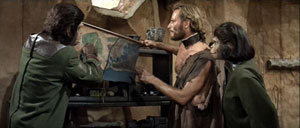 Also effective are the performances behind the apes themselves. John Chambers, who honed his talents developing prosthetics for war victims, used innovative techniques to create lifelike and realistic ape masks that look a little silly today but were quite groundbreaking for the time, so much in fact that the Academy of Motion Picture Arts and Sciences had to create a special award to recognize his efforts. Even with the great makeup, though, it is the performances from the actors that sell the tale. Classically trained British theatrical actor Maurice Evans brings a Shakespearean gusto to the character of Zaius, and Roddy McDowall, destined to become the
Also effective are the performances behind the apes themselves. John Chambers, who honed his talents developing prosthetics for war victims, used innovative techniques to create lifelike and realistic ape masks that look a little silly today but were quite groundbreaking for the time, so much in fact that the Academy of Motion Picture Arts and Sciences had to create a special award to recognize his efforts. Even with the great makeup, though, it is the performances from the actors that sell the tale. Classically trained British theatrical actor Maurice Evans brings a Shakespearean gusto to the character of Zaius, and Roddy McDowall, destined to become the face voice of the Apes franchise, gives a strong performance as the inquisitive but reasonably cautious Cornelius.
It is Kim Hunter's portrayal of Zira, however, that stands strongest among the cast. This comes as no surprise as she too briefly felt the wrath of the dreaded blacklist and was incredibly passionate about the project. The level of emotion she conveys through just her eyes and subtle movements of the cumbersome facemasks is really quite staggering, bringing a necessary level of heart and compassion to an otherwise rigid cast, and the look she gives to the camera when Taylor utters his famous first phrase is priceless. Even Charlton Heston, whose over-the-top style is the stuff of parody legend, comes across perfectly in this film. Taylor is a misanthrope, ostensibly taking this deep space mission because he is so tired of humanity that he just has to get away and see what else is out there. It helps the film and adds a sense of realism that he is a loud-mouth and forceful character who doesn't necessarily represent the best humanity has to offer, and yet he is the one left standing to defend the entire race against those who would have it extinct.
 Adding to all of this is Jerry Goldsmith's remarkably daring and unconventional score. It is my opinion that Goldsmith is our greatest American film composer, and with Planet of the Apes' organic and impressionistic music, his unique talents are in top form. Using whatever sound-making devices he could get his hands on -- including kitchen utensils, a ram's horn, and a Brazillian cuika -- the film's score is almost completely devoid of any hummable themes, and the echoed pizzicato strings help create the disorienting, alien world envisioned by director Franklin J. Schaffner. Even more impressive than the music itself are the choices made for when to use no music at all, most notably the film's legendary finale, punctuated simply by the crashing waves of the ocean as the credits roll.
Adding to all of this is Jerry Goldsmith's remarkably daring and unconventional score. It is my opinion that Goldsmith is our greatest American film composer, and with Planet of the Apes' organic and impressionistic music, his unique talents are in top form. Using whatever sound-making devices he could get his hands on -- including kitchen utensils, a ram's horn, and a Brazillian cuika -- the film's score is almost completely devoid of any hummable themes, and the echoed pizzicato strings help create the disorienting, alien world envisioned by director Franklin J. Schaffner. Even more impressive than the music itself are the choices made for when to use no music at all, most notably the film's legendary finale, punctuated simply by the crashing waves of the ocean as the credits roll.
Not everything in the script conforms to logic, however. The spaceship's lone female crewmember, Stewart (Dianne Stanley), dies of old age when the ship malfunctions and her cryosleep chamber is damaged. Were this a tale of long-term suspended animation, this would make some sense, but Taylor's opening monologue establishes quite clearly that they are only in space for a cosmically short period of time, testing Einstein's Theory of Special Relativity Dr. Hasslein's Theory of Time. And what about this theory-testing journey through space and time? If Dr. Hasslein's beliefs are proven correct, whom are they going to tell? Still, these science fiction holes are of little consequence when compared with the meat of the film, which succeeds in nearly every possible way.
It is a rare occurrence when so many differing factors come together so successfully to create a film, but Planet of the Apes is a prime example of just that. The story is compelling, the performances are right on target, the makeup and direction are effective, and the music is unlike anything done before or since. The film ends with one of the most striking and famous visuals in motion picture history, and there is no doubt this finale is part of what cemented its place as a cultural phenomenon, but the film stands the test of time nearly 40 years later because the social, political, and moral questions it addresses are still valid today. While we continue to advance, we still fall into many of the same traps, and Apes serves as a necessary reminder of our weaknesses and a warning to us all.
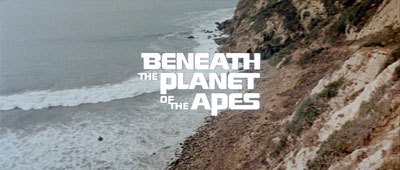

During production of the original, the prospect of making sequels was never really addressed, so when the film opened to such enormous success, the powers that be were left scrambling about to squeeze some more money out of the concept. Unfortunately, no one really had a good idea for where to take the story. Rod Serling was asked to assist once more, but his concept of Taylor going Rambo on the apes in the Forbidden Zone until a rescue party of humans mysteriously falls from the sky didn't really inspire producer Mort Abrahams. Later, Serling would admit that his idea wasn't particularly good anyway. Pierre Boulle also submitted a treatment for the story, an uninspired reversal of fortune where Taylor and Nova somehow lift humanity back to greatness all the while turning back the clock on the apes' evolutionary progress. Neither idea showed much promise, opening the door for Abrahams to go forward with many of his own concepts. By the time poet/film critic Paul Dehn signed on to "write" the actual screenplay, it had become a hodgepodge of disjointed concepts cobbled together by executives in search of more money.
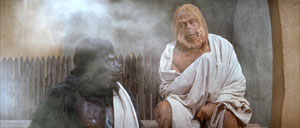 The screenplay was just the beginning of Beneath's preproduction problems. Don Medford, originally slated to direct the piece, angrily bailed from the project early in development, so they brought in Ted Post to takeover the job. Post, who had quite a bit of experience in television, including 4 episodes of the original Twilight Zone, quickly found himself irritated with the direction of the film and Abrahams' insistence on hackneyed plot devices. While he remained on the project, he only did so out of obligation and bitterly resented the entire experience. His own attempts to rework the script into something tolerable were met with much friction, and while many of his ideas had quite a bit of dramatic merit, few of them found their way into the final product. The problems with the script ran so deep that even the picture's leading man, James Franciscus, took it upon himself to submit what amounted to an entire rewrite of every scene he was in, a slap in the face to producer Mort Abrahams, who by now was responsible for most of the plot. (Not surprisingly, this was Abrahams one and only major writing credit.)
The screenplay was just the beginning of Beneath's preproduction problems. Don Medford, originally slated to direct the piece, angrily bailed from the project early in development, so they brought in Ted Post to takeover the job. Post, who had quite a bit of experience in television, including 4 episodes of the original Twilight Zone, quickly found himself irritated with the direction of the film and Abrahams' insistence on hackneyed plot devices. While he remained on the project, he only did so out of obligation and bitterly resented the entire experience. His own attempts to rework the script into something tolerable were met with much friction, and while many of his ideas had quite a bit of dramatic merit, few of them found their way into the final product. The problems with the script ran so deep that even the picture's leading man, James Franciscus, took it upon himself to submit what amounted to an entire rewrite of every scene he was in, a slap in the face to producer Mort Abrahams, who by now was responsible for most of the plot. (Not surprisingly, this was Abrahams one and only major writing credit.)
By the time shooting began, few of the principles had any genuine faith in the quality of the project. This frustrated disconnect between the producers, writers, and director certainly kept Beneath's development from gaining any real creative momentum, but it was Charlton Heston's steadfast desire to have little part in the sequel that really through the project into complete disarray. It was bad enough that they didn't know what to do with the film, but to do it without Taylor as well was just too much. Eventually, Heston would be convinced to take part in the film long enough to introduce new characters and then be killed off, but the already thin script simply could not compensate for the loss of such a major fixture of the original.
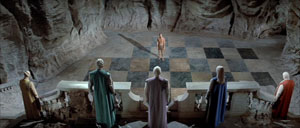 Beneath the Planet of the Apes, therefore, follows the journey of Brent (Franciscus), another astronaut whose crew conveniently followed Taylor's ship on the same trajectory in some kind of poorly defined "rescue mission". How did they know anything was even wrong? What type of rescue did they intend to mount? These questions are not addressed, but really, what would be the point. Brent's exposure to the harsh new world is far less dramatic as he quickly meets up with Nova (Linda Harrison) from the first film and learns that Taylor has already made quite the impression on the inhabitants. He also meets up with Zira and Cornelius (played by David Watson, as McDowall was directing his first and only feature film Tam Lin), where he spends half the film jumping through the same hoops we saw Taylor struggle with in the original. As a consequence, nearly half of the film is wasted on mindless chase sequences and exposition to remind the audience what goes on in this place and establish that Brent is now the focal point of the story.
Beneath the Planet of the Apes, therefore, follows the journey of Brent (Franciscus), another astronaut whose crew conveniently followed Taylor's ship on the same trajectory in some kind of poorly defined "rescue mission". How did they know anything was even wrong? What type of rescue did they intend to mount? These questions are not addressed, but really, what would be the point. Brent's exposure to the harsh new world is far less dramatic as he quickly meets up with Nova (Linda Harrison) from the first film and learns that Taylor has already made quite the impression on the inhabitants. He also meets up with Zira and Cornelius (played by David Watson, as McDowall was directing his first and only feature film Tam Lin), where he spends half the film jumping through the same hoops we saw Taylor struggle with in the original. As a consequence, nearly half of the film is wasted on mindless chase sequences and exposition to remind the audience what goes on in this place and establish that Brent is now the focal point of the story.
Cornelius and Zira, two of the great strengths of the original, are largely pushed aside in favor of more interaction between Zaius and the gorilla military leader Ursus (James Gregory). In truth, this probably wasn't that significant a loss, as Watson had nowhere near the chemistry with Hunter that McDowall had in the previous film. Ursus is a drum-beating warlord, famously crying out to his people, "The only good human is a dead human!" Since the first film's conclusion, many expeditions have ventured into the Forbidden Zone, revealing a dangerous race within, and Ursus is determined to wage war on them. While Gregory gives a very solid performance in the role, his actions lack any real motivation, and worse, the allegory being developed is far less subtle and compelling that its predecessor. Ursus beats the point to death, declaring, "The only thing that counts is power, naked merciless force!" Meanwhile, some of the chimpanzees stage a laughable anti-war rally in the spirit of Vietnam protests, a scene that to this day director Ted Post insists was filmed behind his back by producer Mort Abrahams. It is all very heavy-handed and completely ineffective.
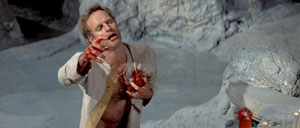 Buried deep within the script are some interesting ideas, most notably the concept that after humanity destroyed itself in nuclear war, the last remnants of the race survived underground for thousands of years. In that time, they have become a warped shell of humanity, literally worshipping a doomsday bomb from ages past and protecting themselves with telepathic intimidation. As Brent ventures beneath the city and discovers all of this, the film finally takes shape, particularly when Charlton Heston is finally given something to do. In another great makeup exhibition, John Chambers presents the inhabitants of this underground community in a decidedly creepy fashion, and coupled with William Creber's creative matte paintings and Leonard Rosenman's disturbing score (Jerry Goldsmith wisely followed Franklin J. Schaffner to the set of Patton), it creates an uneasy otherworldly experience for the viewer. Unlike Taylor and Brent, who are largely persecuted for simply being different, these mutants really do represent something to be feared.
Buried deep within the script are some interesting ideas, most notably the concept that after humanity destroyed itself in nuclear war, the last remnants of the race survived underground for thousands of years. In that time, they have become a warped shell of humanity, literally worshipping a doomsday bomb from ages past and protecting themselves with telepathic intimidation. As Brent ventures beneath the city and discovers all of this, the film finally takes shape, particularly when Charlton Heston is finally given something to do. In another great makeup exhibition, John Chambers presents the inhabitants of this underground community in a decidedly creepy fashion, and coupled with William Creber's creative matte paintings and Leonard Rosenman's disturbing score (Jerry Goldsmith wisely followed Franklin J. Schaffner to the set of Patton), it creates an uneasy otherworldly experience for the viewer. Unlike Taylor and Brent, who are largely persecuted for simply being different, these mutants really do represent something to be feared.
Unfortunately, any analysis of this situation is brushed aside in favor of long musical sequences and semi-impressive visuals. By the time the film draws to a close, it really is difficult to care about what happens to any of them. Brent is little more than Diet Taylor, and Nova is just dragged along for the ride (yes, even more so than in the original). At times in the film, it seems the three of them have little purpose other than to observe as events play themselves out. The mutants are a creepy disillusioned bunch unlikely to elicit sympathy, and the gorilla army certainly isn't warming any hearts either. While some have criticized the film's ultimate conclusion as hopelessly pessimistic and unsatisfying, considering all that went on in the 90 minutes leading up to it, it seems just about the only way to possibly resolve this mess. Heston himself was credited with the idea, regretting his part in the film and wanting no more of it. Along with Fox studio head Richard Zanuck, who was turning in his key to the executive washroom, the two were determined that this be the last Apes picture ever made. Thankfully (?), that would not be the case.
With a greater focus on a compelling story, Beneath the Planet of the Apes could have been an intriguing follow-up to a classic. It has some interesting ideas and raises some worthy questions about the nature of humanity. Sadly, the finished product only tangentially approaches whatever promise it had, and while it made a killing at the box office on just over half the original's budget, it is largely a dramatic failure, a disaster that most of the principles look back on with embarrassment and regret.
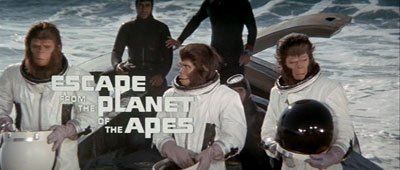

Beneath the Planet of the Apes was released on May 26, 1970. By mid-June, Paul Dehn was already piecing together ideas for a sequel with help from producer Arthur P. Jacobs. Likely due to the greatness of the original, audiences flocked to the theater to see the follow-up in spite of its poor quality, and it was enough for Fox to greenlight a third film in what was now becoming a franchise. After blowing up the entire planet, however, their options for stories to tell were pretty limited. Remarkably, they hit on a workable concept almost immediately, and in stark contrast to the previous film, the initial script and ideas went to production under the title Escape from the Planet of the Apes with hardly any changes.
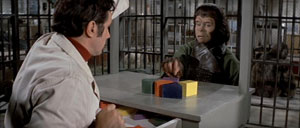 In fact, the script would only be the tip of the iceberg when it came to distancing this third film from its predecessor. Mort Abrahams, the driving force of Beneath, had moved on to other projects and was replaced by Frank Capra, Jr. as associate producer. Roddy McDowall was back to reprise his role as the inquisitive but measured Cornelius, and the brilliant Jerry Goldsmith returned to bring the film to life with his scoring talents. Behind the scenes, nearly everything came together with comparatively surprising ease, and it was a complete reversal of what transpired just a year earlier.
In fact, the script would only be the tip of the iceberg when it came to distancing this third film from its predecessor. Mort Abrahams, the driving force of Beneath, had moved on to other projects and was replaced by Frank Capra, Jr. as associate producer. Roddy McDowall was back to reprise his role as the inquisitive but measured Cornelius, and the brilliant Jerry Goldsmith returned to bring the film to life with his scoring talents. Behind the scenes, nearly everything came together with comparatively surprising ease, and it was a complete reversal of what transpired just a year earlier.
Appropriately, the film's plot is also a complete reversal. Escape establishes the premise that Cornelius and Zira, along with ahead-of-his-time scientific genius Dr. Milo (Sal Mineo), resurrect Taylor's spaceship from the ocean deep and pilot it into space just prior to the end of all things. Through the magic of Hollywood, the planet's explosion somehow sends the ship backward in time to 1973, not too long after Taylor's crew initially left Earth. This setup, while intriguing, requires some serious suspension of disbelief. The original film, although disguised with some silly technobabble and flawed in its own right, is based around a very plausible scientific reality, that traveling at near the speed of light will send you relatively forward through time with respect to the launch site. With Escape, however, we have the added weight of a convenient time tunnel linking present day Earth with its future self of 2000 years. Fortunately, this is just the setup, and once the heart of the story gets underway, it is easy to simply accept it for what it is and enjoy the developing tale.
 That tale becomes a film in two parts: the light-hearted fish-out-of-water story of talking chimpanzees from the future dropping in on 1973 Southern California followed by the much darker pursuit of the American government to prevent their procreation once fear takes over. Both sections of the film work quite well, but it is definitely the first half that makes it such a special picture. In many ways, Kim Hunter's Zira was the heart of the original classic, and in Escape, her character flourishes even more. This time, however, she supported in much greater capacity by Roddy McDowall's Cornelius. The two of them are an absolute joy to watch, and in an interesting dynamic, their performances in Escape are the most "human" of any in the franchise. In one of the great scenes from the film, a hearing committee formed by the President and observed by the press is examining these strange new guests. Flippantly responding to Zira's spoken word, the chairman says, "Mechanical mimicry! Unique in an ape vocally, without a doubt, but -- does the other one talk?" Cornelius smiles at his wife and answers, "Only when she lets me."
That tale becomes a film in two parts: the light-hearted fish-out-of-water story of talking chimpanzees from the future dropping in on 1973 Southern California followed by the much darker pursuit of the American government to prevent their procreation once fear takes over. Both sections of the film work quite well, but it is definitely the first half that makes it such a special picture. In many ways, Kim Hunter's Zira was the heart of the original classic, and in Escape, her character flourishes even more. This time, however, she supported in much greater capacity by Roddy McDowall's Cornelius. The two of them are an absolute joy to watch, and in an interesting dynamic, their performances in Escape are the most "human" of any in the franchise. In one of the great scenes from the film, a hearing committee formed by the President and observed by the press is examining these strange new guests. Flippantly responding to Zira's spoken word, the chairman says, "Mechanical mimicry! Unique in an ape vocally, without a doubt, but -- does the other one talk?" Cornelius smiles at his wife and answers, "Only when she lets me."
One of the interesting things about Escape from the Planet of the Apes is that humanity does not initially respond with fear and distrust. Certainly, there is a lot of confusion involved until it is established that the apes are intelligent and civilized creatures, but for the most part they are embraced by the press and the public. For much of the film, they are celebrities of a sort, quickly taking in numerous cultural experiences, and Dehn's script takes the audience on a journey through some of our own strengths and weaknesses as seen through their eyes. It's fun, it's light, and it just oozes with an early 1970s vibe, right down to Goldsmith's electric guitar and steel drum riffs.
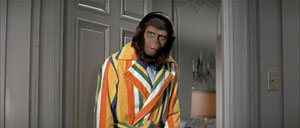 The tone of the film slowly begins to shift and become something much darker when we learn that Zira is pregnant. Otto Hasslein (Eric Braeden), the man whose theories set this whole chain of events in motion, has many reservations, and with some trickery, he learns the details about how Earth came to be ruled by apes from Zira. He becomes convinced that the offspring of these future apes could spell the downfall of mankind, and he is determined to prevent the baby from being born. The final act is not as compelling as what leads up to it, but it is a solid conclusion to a surprisingly entertaining film. Much of this is because of some very strong performances in supporting roles. While the human doctor counterparts to Zira and Cornelius (Bradford Dillman as Dr. Lewis Dixon and Natalie Trundy as Dr. Stephanie Branton) are serviceable but a bit dull, William Windom's believable turn as the President of the United States and Braeden's performance as Hasslein add a real weight to the piece that is grounded in some realism. Hasslein may be the heavy, but he has some logic to back up his claims, and the President's more debatable decisions come from reasoned analysis and internal moral struggle. Ricardo Montalban also delivers some nice work as Armando.
The tone of the film slowly begins to shift and become something much darker when we learn that Zira is pregnant. Otto Hasslein (Eric Braeden), the man whose theories set this whole chain of events in motion, has many reservations, and with some trickery, he learns the details about how Earth came to be ruled by apes from Zira. He becomes convinced that the offspring of these future apes could spell the downfall of mankind, and he is determined to prevent the baby from being born. The final act is not as compelling as what leads up to it, but it is a solid conclusion to a surprisingly entertaining film. Much of this is because of some very strong performances in supporting roles. While the human doctor counterparts to Zira and Cornelius (Bradford Dillman as Dr. Lewis Dixon and Natalie Trundy as Dr. Stephanie Branton) are serviceable but a bit dull, William Windom's believable turn as the President of the United States and Braeden's performance as Hasslein add a real weight to the piece that is grounded in some realism. Hasslein may be the heavy, but he has some logic to back up his claims, and the President's more debatable decisions come from reasoned analysis and internal moral struggle. Ricardo Montalban also delivers some nice work as Armando.
Escape from the Planet of the Apes is everything Beneath could not achieve. By turning the tables on the entire premise, Paul Dehn's script allows us to see humanity through the eyes of outsiders and provide sometimes poignant observations about us. This change also kept production costs down, only needing ape makeup for 3 major characters (although someone should have been fired for the gorilla costume used at the zoo), and the film was produced for just over $2 million. With a solid script, lots of good-natured humor, and Hunter and McDowall in top form as the lead characters, Escape stands as one of the stronger films in the series and a worthy successor to the original.
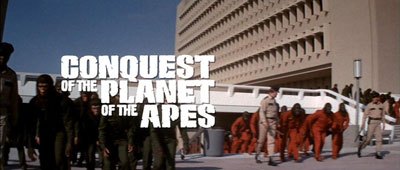

Now becoming an annual tradition, writer Paul Dehn began working on the next film in the franchise, Conquest of the Planet of the Apes, months before Escape even hit theaters. It was a given that a fourth film would be made, provided that Escape was profitable (in the end, it grossed about $10 million more than its $2.2 million production cost), so once the numbers started coming in, the studio gave the go-ahead for the next chapter in the saga to be released approximately one year later. As with the previous films, the budget was slashed once more, this time down to about $1.7 million, presenting a daunting task for the director considering the scope of this script as compared to its predecessor.
Selected for that task was J. Lee Thompson, who directed producer Arthur P. Jacobs' very first project What a Way to Go! in 1964. Thompson was already connected with the franchise, originally slated to direct the first film before early production delays forced him to move on. He was also asked to direct the second and third films, but wisely turned down the second after taking a look at the questionable script and perhaps not-so-wisely turned down the third because it didn't focus on an ape society. This time, however, he accepted the project and the daunting task of shooting such an involved script on a comparatively small budget.
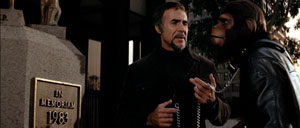 Conquest picks up approximately 18 years after Escape's climactic final act in 1991. A mysterious plague wiped out the dog and cat population years earlier, and people turned to primates as household pets. Over time, though, the role of apes in society has mutated from that of pets to a form of government enforced slave labor. Armando (Ricardo Montalban), the circus owner who sheltered Cornelius and Zira's child from government agents in the previous film, has decided that the maturing young adult is ready to venture into the main city and learn the truths and realities of modern civilization. Once confronted with this horrific reality, Caesar (Roddy McDowall once more) lets out a foolish outburst, giving away his ability to speak and leading to the capture of his fatherly friend.
Conquest picks up approximately 18 years after Escape's climactic final act in 1991. A mysterious plague wiped out the dog and cat population years earlier, and people turned to primates as household pets. Over time, though, the role of apes in society has mutated from that of pets to a form of government enforced slave labor. Armando (Ricardo Montalban), the circus owner who sheltered Cornelius and Zira's child from government agents in the previous film, has decided that the maturing young adult is ready to venture into the main city and learn the truths and realities of modern civilization. Once confronted with this horrific reality, Caesar (Roddy McDowall once more) lets out a foolish outburst, giving away his ability to speak and leading to the capture of his fatherly friend.
Nonetheless, Caesar is able to avoid capture himself, and since all apes look alike to most humans, he finds his way into the ape-labor processing system, "learning" to do simple household tasks in preparation to be sold to a human owner. The whole experience is exceedingly degrading to an intelligent and socially conscious individual like Caesar, and rage begins to build within him with regard to the horrors he is witnessing. Aided by the fact that apes are being used as labor force in just about every location in the city, Caesar slowly begins piecing together a labor force of his own in hopes of organizing and ape revolt against the government and leading them to freedom.
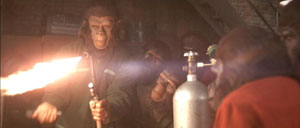 As Caesar, McDowall delivers his best performance in the series, and he creates a much more dynamic and interesting character than his father Cornelius. Ricardo Montalban also adds a significant amount of heart and understanding to the piece as he gives life to what was a relatively small part in the previous film. Also effective are the totalitarian Governor Breck (Don Murray), whose measured performance as the villain of the piece works very well, and his ruthless henchman Chief Inspector Kolp (Severn Darden).
As Caesar, McDowall delivers his best performance in the series, and he creates a much more dynamic and interesting character than his father Cornelius. Ricardo Montalban also adds a significant amount of heart and understanding to the piece as he gives life to what was a relatively small part in the previous film. Also effective are the totalitarian Governor Breck (Don Murray), whose measured performance as the villain of the piece works very well, and his ruthless henchman Chief Inspector Kolp (Severn Darden).
Conquest is quite obviously an allegory for America's own history of slavery, and it not-so-subtly employs a black character named MacDonald (Hari Rhodes) to give voice to these allusions. Rhodes is strong enough in the role, however, that it avoids becoming overly preachy and side-steps the silliness we saw with the war protestors in Beneath. Further attaching itself to this nation's struggle with race relations, Thompson staged the battle sequences between man and ape after the news footage from the 1965 Watts Riots, where Southern Los Angeles's racial tension boiled over into 5 days of large-scale looting and rioting after a routine traffic stop.
Clocking in at barely 88 minutes, this fourth film in the franchise feels closer to a television special than a major motion picture. While Thompson's direction is strong considering what he has to work with, the film never really establishes that larger-than-life quality of the original, or even Beneath. Worse, its momentum is squandered in the final act, where reportedly the film had to be drastically re-edited because it was too dark and violent. The final product is largely unsatisfying and Caesar's closing speech laughably inappropriate. On the whole, Conquest for the Planet of the Apes is a solid film with some very good performances, particularly from Apes veteran McDowall, but ultimately it leaves you feeling a little cheated by the time the credits roll.
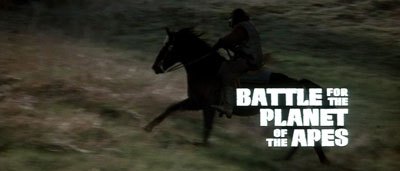

Closing the film franchise would be Battle for the Planet of the Apes, a disaster of a film that feels like a cheap money grab from the remaining fans willing to see anything with Apes in the title. Writer Paul Dehn, who was now a fixture in the franchise, put together an incredibly detailed and involved treatment for a film that would bridge the gap between the events of Conquest and the future we knew would come to pass in Planet and Beneath. It was a dark and pessimistic concept, but it certainly showed quite a bit of promise. Unfortunately, contract negotiations, health problems, and Fox's desire to return to a G-rated family film left Dehn's concept out of the mix, and Jacobs brought in the writing team who penned the screenplay for The Omega Man, John William and Joyce Hooper Corrington, to take over the project.
Retaining little but the basic outline from Dehn's treatment, the Corringtons put together a really cartoonish script that watered down the character of Caesar and presented nothing unique or special to the audience. J. Lee Thompson agreed to return as director before reading the script, a decision for which he would later express regret. At this point, the production team knew it was the last film in the series, Arthur P. Jacobs had sold off all his rights to Fox so they could make a television series, and the 96-minute film (with a budget slashed down to $1.2 million this time) feels as though everyone involved with the project sleepwalked their way to its underwhelming conclusion.
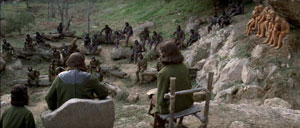 Battle takes place just over a decade after the events of Conquest, with Caesar ruling an "Ape City" somewhat in the style of what is seen in the original film, but far less intricate as it is mostly a set of huts and treehouses. He has married Lisa (Natalie Trundy -- wife of Jacobs -- now in her fourth film and third character), and they have a son aptly named Cornelius (Bobby Porter). Humanity has essentially destroyed itself through nuclear war in the intervening years, although it is never really explained how all this happened, and the apes have all since acquired the power of speech. Shunning the totalitarian style of Governor Breck, Caesar's Ape City is ostensibly run in a more egalitarian manner, but humans do occupy a lower rung on the social ladder, and if the gorilla leader Aldo (Claude Akins) had his way, they would be treated with much more contempt. Severn Darden reprises his role as Kolp, even more maniacal than before and now promoted to Governor after the death of Breck (Murray wisely steered clear of this one), and the character of "MacDonald" who helped Caesar with his uprising in Conquest is now played by Austin Stoker with a throw-away line that indicates he's really his "brother".
Battle takes place just over a decade after the events of Conquest, with Caesar ruling an "Ape City" somewhat in the style of what is seen in the original film, but far less intricate as it is mostly a set of huts and treehouses. He has married Lisa (Natalie Trundy -- wife of Jacobs -- now in her fourth film and third character), and they have a son aptly named Cornelius (Bobby Porter). Humanity has essentially destroyed itself through nuclear war in the intervening years, although it is never really explained how all this happened, and the apes have all since acquired the power of speech. Shunning the totalitarian style of Governor Breck, Caesar's Ape City is ostensibly run in a more egalitarian manner, but humans do occupy a lower rung on the social ladder, and if the gorilla leader Aldo (Claude Akins) had his way, they would be treated with much more contempt. Severn Darden reprises his role as Kolp, even more maniacal than before and now promoted to Governor after the death of Breck (Murray wisely steered clear of this one), and the character of "MacDonald" who helped Caesar with his uprising in Conquest is now played by Austin Stoker with a throw-away line that indicates he's really his "brother".
Book-ended with retrospective speeches from 2670 by the famous "Lawgiver" (played by legendary actor/director John Huston) and filled with lots of uninvolving discussion between main characters, Battle contains precious little action to warrant its title. If there were a "battle" for the planet, it likely happened during the time between the previous film and this one. What ultimately concludes the fight between the remnants of humanity and Caesar's new Ape City in this film plays out more like a local town's war re-enactment than anything epic or convincing. One thing often ignored by the Apes series is how the events of one small pocket of civilization are able to affect the entire planet, and no film does a worse job of helping us understand than this one.
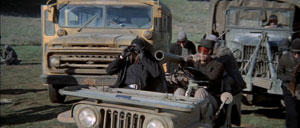 Of note, this DVD release of Battle for the Planet of the Apes contains the extended television cut that runs 96 minutes instead of the 86-minute version that was shown in theaters during the summer of 1973. Among the material included in those 10 minutes is a subplot involving Alma (France Nuyen), one of the humans mutated from radioactive fallout who lives in the ruins of the underground city from Conquest. When Kolp heads off to "battle" the apes, she is left behind as the keeper of the Alpha-Omega bomb, the doomsday device at the center of Beneath the Planet of the Apes. Although a little clumsy in their execution, the addition scenes help give some explanation as to why the mutants act the way they do when Brent encounters them in the second film.
Of note, this DVD release of Battle for the Planet of the Apes contains the extended television cut that runs 96 minutes instead of the 86-minute version that was shown in theaters during the summer of 1973. Among the material included in those 10 minutes is a subplot involving Alma (France Nuyen), one of the humans mutated from radioactive fallout who lives in the ruins of the underground city from Conquest. When Kolp heads off to "battle" the apes, she is left behind as the keeper of the Alpha-Omega bomb, the doomsday device at the center of Beneath the Planet of the Apes. Although a little clumsy in their execution, the addition scenes help give some explanation as to why the mutants act the way they do when Brent encounters them in the second film.
On the whole, while Claude Akins gives his always strong performance as Caesar's nemesis in the role of Aldo, and Lew Ayres is fun to watch as Mandemus, Battle for the Planet of the Apes is a painful spectacle that, like its predecessor, is really just a glorified television movie. Fox executives frequently attributed Apes' success to bringing in the younger demographics, and if any film in the series is "made for kids", this one is it. It is unfortunate that the film franchise closed in this manner, and when the absurd final sequence plays out (that the Corringtons rightly fought to keep out of the film), all you can do is throw up your hands, roll your eyes, and shrug.
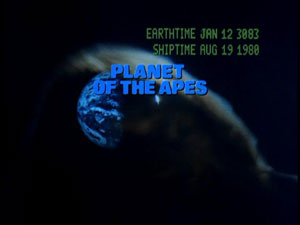

While the idea of a Planet of the Apes television series had been tossed around since the success of the first feature, it never really took form since the films were doing so well at the box office. With the key players losing interest in doing another feature, including producer Arthur P. Jacobs who sold off his rights to the franchise to finance other projects, and the public interest showing signs that they probably wouldn't rush to the theater to see anymore adventures, 1974 presented the opportunity to revisit those initial discussions and bring Apes to the small screen. In fact, CBS seriously considered the idea as early as 1973, but produced The New Perry Mason instead, a dreadful what-were-they-thinking remake of the original starring Monte Markham in the title role (Raymond Burr was off making the hit Ironside) alongside perennial Match Game guest Brett Somers. This series predictably failed, and after the televised versions of the feature films garnered great ratings, CBS went into full production on the Planet of the Apes television series to premiere in the Fall of 1974 on Fridays at 8:00 pm, opposite NBC's mega-hits Sanford and Son and Chico and the Man. (It is interesting to note that CBS was dominating television at the time, but going against the soon-to-fail Planet of the Apes gave the two NBC comedies such a ratings boost that it was their highest rated regular hour-long block in a span of over 15 years, from Laugh-In in 1968 all the way to the one-two punch of The Cosby Show and Family Ties in 1985.)
For the task of developing this new series, Fox executive and show producer Stan Hough turned once again to Rod Serling, who was hired to establish the series mythology and write the initial scripts. Much of the show's basic structure would come from Serling's ideas, but in the end Art Wallace (known for his work on Dark Shadows as well as Star Trek's "Obsession" and "Assignment: Earth") would be tapped to finish developing it for television and pen the first two episodes. Ironically, Herbert Hirschman, who 10 years prior had stepped in to produce Serling's own Twilight Zone when Buck Houghton left after the third season, was then hired as executive producer. The series would last 14 episodes before being cancelled due to low ratings.
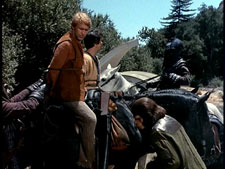 Planet of the Apes, the television series, confusingly takes place in the year 3085, about 900 years before Taylor crash-lands into future New York's ape-run community. As always, the plot concerns a group of astronauts from the past stumbling through some kind of time warp to a future Earth. This time, the surviving astronauts are Alan Virdon (Ron Harper) and Peter Burke (James Naughton), who leave their Earth in the year 1981 and are seemingly unaware of the previous human missions or the massive publicity surrounding the arrival of the two talking apes less than 10 years before their launch (I'm sure they were just really busy training). They crash in what we later learn to be the former San Francisco area and are met by a human named Farrow (Royal Dano), who leads them to safety and explains what the audience already knows: this land is ruled by talking apes, and if they are captured, it spells major trouble.
Planet of the Apes, the television series, confusingly takes place in the year 3085, about 900 years before Taylor crash-lands into future New York's ape-run community. As always, the plot concerns a group of astronauts from the past stumbling through some kind of time warp to a future Earth. This time, the surviving astronauts are Alan Virdon (Ron Harper) and Peter Burke (James Naughton), who leave their Earth in the year 1981 and are seemingly unaware of the previous human missions or the massive publicity surrounding the arrival of the two talking apes less than 10 years before their launch (I'm sure they were just really busy training). They crash in what we later learn to be the former San Francisco area and are met by a human named Farrow (Royal Dano), who leads them to safety and explains what the audience already knows: this land is ruled by talking apes, and if they are captured, it spells major trouble.
So, of course, they are captured. Soon they meet Dr. Zaius (Booth Colman), confusing to be sure but not the same guy, and his assistant Galen (Roddy McDowall back for more). Zaius explains that he has had dealings with human astronauts from the past before and fears their power to destroy (their identities are intentionally kept vague to give the illusion of a sequel series while maintaining some semblence of continuity). Galen, however, is apprehensive about the way Zaius is treating the humans, and he soon comes to realize that they possess great knowledge and are to be treated with more respect. In trying to help them, Galen unwantingly kills a member of the gorilla army, forcing him to flee the city alongside his new astronaut pals.
The television series establishes a familiar and consistent pattern used in countless series from The Fugitive to The A-Team. The three heroes are on the run, ruthlessly hunted by gorilla leader Urko (Mark Lenard), and as they hop from town to town, they get into a number of 49-minute adventures. As this series is set somewhere between apes overthrowing man and Taylor's discovery of a mute human race, the human characters do talk and exhibit varying levels of skill and intelligence. Sometimes the daring trio works to save humans from apes, and sometimes they work to save the apes from themselves, but make no mistake, they are always saving the day.
 Surprisingly, with such a basic formula, it is a rather entertaining show. McDowall's portrayal of Galen is much less rigid than Cornelius and not nearly as weighty as Caesar. He is a youthful and fun-loving character who has a very good sense of humor, and while he doesn't like being on the run for his life and constantly doing what the humans tell him to do, he nonetheless appreciates the value of traveling from town to town helping others and learning a lot along the way. Burke and Virdon are also quite likeable, particularly Burke who has a sarcastic quip for nearly every situation. And, as you would expect, the great Mark Lenard is excellent as the gorilla leader Urko, adding a level of contemplative logic and respectable honor that was missing in his counterpart from the films, Ursus.
Surprisingly, with such a basic formula, it is a rather entertaining show. McDowall's portrayal of Galen is much less rigid than Cornelius and not nearly as weighty as Caesar. He is a youthful and fun-loving character who has a very good sense of humor, and while he doesn't like being on the run for his life and constantly doing what the humans tell him to do, he nonetheless appreciates the value of traveling from town to town helping others and learning a lot along the way. Burke and Virdon are also quite likeable, particularly Burke who has a sarcastic quip for nearly every situation. And, as you would expect, the great Mark Lenard is excellent as the gorilla leader Urko, adding a level of contemplative logic and respectable honor that was missing in his counterpart from the films, Ursus.
While entertaining, most of the series does put a heavy strain on the suspension-of-disbelief muscle. Putting aside the fact that the circumstances are outlandish to begin with (and that dogs apparently exist again despite the already established pet-destroying plague, and that electric lighting still works inside ancient ruins), our human heroes are experts in everything and would make for excellent recruitment propaganda for the space program. Between the two of them, they are experts in agriculture, architecture, horse-back riding, spear-fishing, hand-to-hand combat, primitive manned flight (I'll give them that one -- they are pilots), and not only can they diagnose malaria at the drop of a hat, but they know how to both identify the South American Cinchona tree and turn its bark extract into quinine. If you have a problem, if no one else can help, and if you can find them, maybe you can hire a couple of ruggedly handsome astronauts from the past. Also difficult to swallow is just how inept everyone on the planet is except our intrepid adventurers. You would think that once in a while the apes would actually get something right on their own without the help of our two humans.
One really frustrating aspect of this series is a thread that is established in the episode titled "The Legacy". In the ruins of a long-abandoned city, they find a computer and holoprojector that would make Landru proud. The projection informs them that the sum total of human knowledge has been carefully preserved and is stored on similar computers scattered about the planet. After tracking one of these down and subsequently losing control of it to the bewildered apes, Burke and Virdon seemingly forget about the whole thing. Perhaps this thread would have been picked up later in future episodes, but it is frustrating to have such a concept dangled in front of the audience only to be cast aside once that episode's credits rolled.
Still, for all its 1970s silliness, Planet of the Apes is a relatively charming television series with a good sense of humor about itself and a host of likeable characters. Not all of the humans are good guys, and not all of the apes are bad guys, and this keeps the series on its toes. These stories have been told before on similar shows (most every plot seems patterned after a Star Trek episode) and would be told again throughout the years, but the 14 episodes of the series that completed production are entertaining enough to enjoy even 30 years later and represent just the right amount of material to get a feel for the concept without tiring from its repetitive nature.
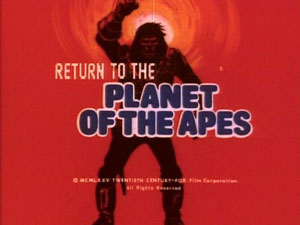

Continuity is largely abandoned for Return to the Planet of the Apes, NBC's 1975 animated final chapter in the original Apes saga. Instead of reusing any human characters, yet another group of astronauts, now searching for a possible location for a second Earth and testing "Dr. Stanton's Time Thrust Theory", are stranded in the planet's future, this time in the year 3979. Bill Hudson (Tom Williams/Richard Blackburn), Jeff Allen (Austin Stoker), and Judy Franklin (Claudette Nevins) are left to fend for themselves against General Urko (Henry Corden) with the help of Zira (Philippa Harris) and Cornelius (Edwin Mills). Characters from different timelines and locations are mixed together, many forgetting or misremembering events they experienced in the films. Not so creatively, Zira nicknames Bill "Blue Eyes", reminiscent of Taylor's "Bright Eyes" from the original.
One interesting area that separates this animated series from everything that came before is that in this version, the apes are quite advanced technologically. In Boulle's original novel, this was always the case, but for obvious budgetary reasons, none of it made it into the film franchise. With animation, however, it was easy to create an elaborately constructed Ape City and showcase the apes driving cars and flying helicopters. Of course, with animation, you can also have flying mutant monsters and creatures that haphazardly shoot lasers out of their eyes. For a Saturday morning cartoon, I guess that's to be expected.
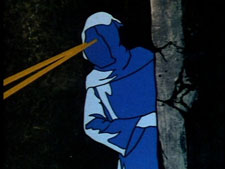
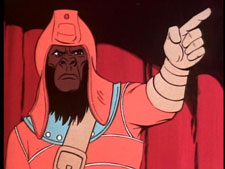
Unlike the live-action television series, the animated series does aim higher when it comes to telling a contiguous story. The main characters are actually developed over time, and the plots progress from one episode to the next. In many ways, it is impressive that a show of this nature would attempt to maintain some form of on-going story when it is so clearly being aimed as a distraction to kids, and some of the plots are way more mature than one would expect. Also, despite its awkward grouping of characters, it more or less maintains the basic themes and character traits established by the original film.
Still, there really isn't anything involving about what happens in this series, and way too much screen time is squandered on poorly animated chase sequences that go on for minutes at a time. In each episode, there is barely 5 minutes of meaningful action and dialogue, the rest of the time wasted on painfully repetitive animated sequences that go nowhere fast and hold no real interest or peril. The 13 episodes that were produced are interesting from a historical perspective and would probably hold some entertainment value as the backbone of a drinking game, but other than that, it just isn't very compelling television outside of its original purpose as mindless distraction for youngsters on Saturday mornings.
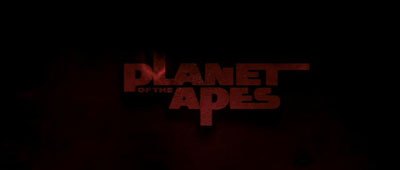

When revisiting the Planet of the Apes franchise, Tim Burton was well aware of the pitfalls of remaking a classic. What if instead of "remaking" the classic, however, he "reimagined" it? Now, that might be worth doing. For example, imagine if instead of insightful and relevant social commentary, it is turned into a purposeless action flick. Imagine if thoughtful and motivated characters are replaced with mindless servants of an uninspired plot. And imagine tacking on an absurd joke of an ending to shamelessly beg for franchise status once more. Sounds like a winner!
Fox's interest in returning to the Apes universe on a grand scale can be traced back as early as 1993, when Oliver Stone began piecing together some initial ingredients for a feature film. Nothing really came of this, and over the next 5 years, various screenwriters and directors (including James Cameron and Michael Bay) would find themselves associated with the project for a brief time, each ultimately moving on to do other things. It wasn't until 2000, when William Broyles Jr. put together a script that everyone loved, that the return to the big screen became a legitimate priority. Ralph Winter and Richard Zanuck (who first invested in the original film) were brought on to produce, and the visionary Tim Burton was hired as director.
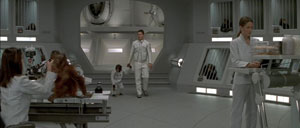 The new Planet of the Apes focuses on Captain Leo Davidson (Mark Wahlberg), an astronaut living aboard a science-oriented space vessel named Oberon in the year 2029. When the Oberon comes across a strange electrical storm, Davidson demands to go investigate it himself, but the more conservative Lt. General (Chris Ellis) in charge of the vessel orders one of the many chimpanzee pilots on-board (Pericles) to go in first. Something goes horribly wrong, though, and they lose contact with Pericles and his ship. Against orders, Davidson steals a small ship of his own and cavalierly races after his ape, a decision that sends him hurtling through some rift in the fabric of time and crash-landing ... where else ... on a planet run by talking apes.
The new Planet of the Apes focuses on Captain Leo Davidson (Mark Wahlberg), an astronaut living aboard a science-oriented space vessel named Oberon in the year 2029. When the Oberon comes across a strange electrical storm, Davidson demands to go investigate it himself, but the more conservative Lt. General (Chris Ellis) in charge of the vessel orders one of the many chimpanzee pilots on-board (Pericles) to go in first. Something goes horribly wrong, though, and they lose contact with Pericles and his ship. Against orders, Davidson steals a small ship of his own and cavalierly races after his ape, a decision that sends him hurtling through some rift in the fabric of time and crash-landing ... where else ... on a planet run by talking apes.
This planet, however, is much different from the one seen in the original films. Instead of a barren desert landscape, Davidson finds himself in a thick jungle, and almost immediately, he is on the run from a very agile group of apes trying to capture him and all the other humans in the area. Once captured, he is taken to Ape City, which further incorporates the jungle concept into an elaborate series of caves and tree houses that dwarfs the sparse commune of Zira and Cornelius. Here he meets Ari (Helena Bonham Carter), a prominent female chimpanzee who is a vocal "human rights" activist and does not approve of the social structure where apes are in charge and humans are treated like slaves. When Davidson ultimately escapes with a group of previously enslaved humans, Ari and her gorilla companion Krull (Cary-Hiroyuki Tagawa) help him avoid the ruthless ape leader General Thade (Tim Roth) and his own right-hand gorilla Colonel Attar (Michael Clarke Duncan).
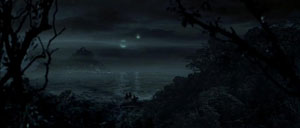 While there are a few moments of heavy-handed animal rights dialogue and a couple of scenes where a group of apes just sit around talking and admiring their amazing costumes, the reimagining of Planet of the Apes is predominantly an action film, a series of chase sequences culminating in a drawn-out final battle between ape and man. As one would expect from a Tim Burton film, the visuals are often breathtaking, and Rick Baker's ape makeup is absolutely fantastic, departing from the budget-conscious originals and allowing each individual ape (even within species) to have his own unique look. Interestingly, Baker won the first Academy Award in the official makeup category in 1981 after John Chambers's work on the original required an honorary award. In terms of visual style, this version of Apes truly does look wonderful and validates much of the $100 million invested in the project. Unfortunately, that is where the success ends, as nothing else about the film works.
While there are a few moments of heavy-handed animal rights dialogue and a couple of scenes where a group of apes just sit around talking and admiring their amazing costumes, the reimagining of Planet of the Apes is predominantly an action film, a series of chase sequences culminating in a drawn-out final battle between ape and man. As one would expect from a Tim Burton film, the visuals are often breathtaking, and Rick Baker's ape makeup is absolutely fantastic, departing from the budget-conscious originals and allowing each individual ape (even within species) to have his own unique look. Interestingly, Baker won the first Academy Award in the official makeup category in 1981 after John Chambers's work on the original required an honorary award. In terms of visual style, this version of Apes truly does look wonderful and validates much of the $100 million invested in the project. Unfortunately, that is where the success ends, as nothing else about the film works.
Tim Roth makes a great villain when he has something to do, but his character is so one-dimensional that it loses a lot of its effectiveness. Ari is also very one-dimensional; she believes in human rights and ... well, that's really it. In fact, aside from a hilarious turn by Paul Giamatti as the orangutan slave driver named Limbo, there isn't an interesting character in the entire film, and none of them seems motivated by anything internal; they simply follow along because the script demands they do so. Worse are the human characters. Davidson befriends (if you can even call it that) an elder human named Karubi (Kris Kristofferson) and his beautiful daughter Daena (Estella Warren), and while both of them possess the power of speech, we find it would be better if they just kept their mouths shut. Warren's performance as Daena is so stiff and lifeless that the mute and awkwardly expressive Nova is actually the more interesting and dynamic character. In the lead, Wahlberg is serviceable as the anti-hero who isn't as interested in saving the day as he just wants to get off this crazy world, but the script gives him so little to work with that he comes across nearly as bland as everyone else.
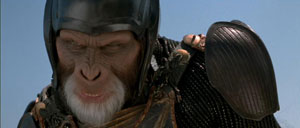 Tim Burton is a brilliant artist, and everyone who is close to him (including Burton himself) will gladly tell you that he tries not to intellectualize things too much, preferring to rely on emotion and feeling. That is part of what makes his films so unique and visually imaginative, but in the case of Planet of the Apes, the project really could have done with some thought, perhaps some logic, and definitely some character motivation. The film culminates in a final battle that employs as many action flick clichés as could be crammed into a film, complete with the wild-eyed kid who gets himself into trouble when trying to help out, the isolated mano-a-mano fights between characters of similar rank in the credits, and a deus ex machina literally descending from the heavens. Sadly, for as great as the makeup and costumes are, the fight choreography in this final battle (and in other parts of the film) is very weak, peppered with characters clearly attached to wires being slung around in physics-defying ways that look terribly silly. By the time the battle draws to its anticlimactic conclusion, the whole effort to watch it has been exhausting, and it's difficult to care what happens to any of these characters once the credits roll.
Tim Burton is a brilliant artist, and everyone who is close to him (including Burton himself) will gladly tell you that he tries not to intellectualize things too much, preferring to rely on emotion and feeling. That is part of what makes his films so unique and visually imaginative, but in the case of Planet of the Apes, the project really could have done with some thought, perhaps some logic, and definitely some character motivation. The film culminates in a final battle that employs as many action flick clichés as could be crammed into a film, complete with the wild-eyed kid who gets himself into trouble when trying to help out, the isolated mano-a-mano fights between characters of similar rank in the credits, and a deus ex machina literally descending from the heavens. Sadly, for as great as the makeup and costumes are, the fight choreography in this final battle (and in other parts of the film) is very weak, peppered with characters clearly attached to wires being slung around in physics-defying ways that look terribly silly. By the time the battle draws to its anticlimactic conclusion, the whole effort to watch it has been exhausting, and it's difficult to care what happens to any of these characters once the credits roll.
Tacked on to the end of the film, and the subject of much controversy, is a laughable ending that is given almost no setup and screams, "Give us a sequel!!!" Related to Boulle's original novel in the most trivial of ways, this conclusion is jarring and nonsensical just for the sake of shock value, it has almost no relevance to the 110 minutes of film preceding it, and it transforms the audience reaction from apathy over an uninvolving action piece into anger for being treated in such an insulting way. As a mindless action flick, the reimagining of Planet of the Apes perhaps would have been easier to swallow had it not tried so hard to shock us and employ so many wink-wink references to the original. That decision to look back on the classic so frequently with cameos and quotable lines proves foolish, as it constantly reminds the audience of what came before and just how inferior this "reimagined" version truly is.
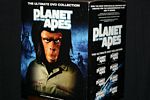   |
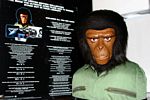  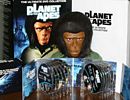 |
| Click any image for a larger version |
PACKAGING
One of the first things you notice about the 12" x 10" x 14.25" box that houses this unbelievable DVD collection is the giant picture of Roddy McDowall's "Caesar" on the side of the box and a notation that reads, "Limited Edition Planet of the Apes bust shown actual size". That's right ... the "ape head" packaging that separates this DVD collection from nearly every other Region 1 release stands an eerie 12 inches tall (a little more if you count Caesar's flowing mane), with a footprint about 10.5 inches wide and 7.5 inches deep. Incredibly detailed, this unique packaging features Caesar in a canvas jumpsuit with zippered pockets, realistic flowing hair, and the creepiest eyes that will ever sit on your DVD shelf. This is a serious collectible.
Thankfully, Fox Home Entertainment has gone the extra mile to ensure that the packaging arrives to the consumer in the best shape possible. The bust is lightly wrapped in thin plastic and housed inside a styrofoam mold that sits within a large box covered by an outer slipcover. While damage may occur to the outer box while in transit, it is unlikely the bust itself will be anything other than originally intended. The DVDs themselves are encased in a 2-inch thick fanned case, similar to Paramount's Star Trek releases, but with 2 panels and a lot more discs. The casing, which is as small as physically possible, slides into the base of the ape head through a plastic enclosure that is revealed by lifting a velcro-attached panel in the canvas outfit. The entire package is very well done and downright disturbing as it stares at you from across your home theater.
The discs for the feature films contain animated menus, and most are pretty clever. The reimagining is a bit too clever at times and can be a pain to navigate through. The four original sequels each include a loud and obnoxious anti-piracy ad at the front of the disc. I'd like to meet the guy who actually thinks these things are effective. Of note, the animated series is presented in an order slightly different from its original airing.
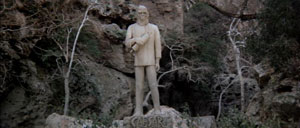
AUDIO
Planet of the Apes is presented with a few audio options -- English 5.1 Dolby Surround and DTS, French 2.0 Dolby Surround, and Spanish 2.0 Dolby Mono -- and it sounds as good as it ever has. The four film sequels only contain English 5.1 Dolby Surround as well as English and French mono tracks, and they are adequate without any noticeable problems, but don't really make the most of the additional surround channels. The live-action television series has both English and French mono, while the animated series has English and Spanish. Neither is anything special, and both exhibit significant muffling, but there's not much you can expect from 1970s television series. Tim Burton's "reimagining" provides English 5.1 Dolby Surround and DTS along with Spanish 2.0 Dolby Surround. Predictably, it sounds incredible and is both crisp and powerful. All of this material is essentially what you find on the previous DVD releases of each title.
Each of the discs feature English and Spanish subtitles, except for the reimagining which is missing the Spanish. The animated series also includes French.
VIDEO
The video quality on this release is a mixed bag. All of the theatrical films are presented in their original 2.35:1 aspect ratios with anamorphic enhancement for 16x9 televisions. With the original and the reimagining, it is the same transfer we saw on the 35th Anniversary and Special Edition releases respectively. Both look fantastic, although it can be argued that the original DVD print for the 1968 classic is superior if you remove the enhancement from the equation. As with its sound, the reimagining looks spectacular. For such a dark film with so many nighttime sequences, the colors come through wonderfully, and it is everything you would expect from a modern DVD release. Looking and sounding so great, it's a shame the film is so awful.
The other four films, anamorphically enhanced on DVD for the first time with this release and the related Legacy Collection, definitely look better than before, particularly Escape which is often very clean. Beneath is really hit or miss, with some sequences looking great and others looking as bad as always. Less attention to detail seems to have been given to Conquest and Battle, and while they do look better, it isn't a staggering improvement.
The live-action television series is a typically confusing blend of beautiful on-set shots and grainy on-location footage, often overly saturated. Considering its age and the fact that you'll run into these problems with most television series of the era, it looks pretty good, but there is a decent amount of print damage. For some reason, despite the relatively adequate quality of the episode content, the title sequence looks absolutely terrible. Still, it's the episodes themselves that really matter, and they look fine for the most part. The animated series is another situation entirely, looking as though it was excavated from VHS tapes at the bottom of a duffle bag in some fan's basement. There is print damage everywhere, and the colors are really muddy. Clearly, these episodes were tossed onto the release with a minimum of effort.
While all of it can be found on other releases, there some wonderful special features in this collection, most of it concentrated on the original 1968 classic and the 2001 reimagining.
On Disc #1, containing the original Planet of the Apes, there are two Audio Commentaries and one Text Commentary. Unfortunately, the audio commentaries are a real letdown. The first is supposed to be with the brilliant composer Jerry Goldsmith, but he is silent for a good 80% of the film, intently watching it himself for the first time in years. When he does speak, what he has to say is fascinating, but it is so rare that it is a disappointing waste of his talents. The second "commentary" is a misnomer, and is really just various audio interviews with Roddy McDowall, Natalie Trundy, Kim Hunter, and John Chambers cobbled together and played against various parts of the film. I would rather just have these presented in isolated interviews than the spliced-apart manner in which they're heard here. Eric Greene, author of Planet of the Apes as American Myth provides the final commentary, and it is in text form, similar to the Okuda commentaries on the Star Trek releases. Greene has quite a bit to "say", and you need to be a fairly quick reader to take in all of it as it flashes across the screen. If you're a die-hard fan of the series, most of it is knowledge you already possess, but it is very interesting nonetheless and would make for great viewing if you're relatively new to the franchise.
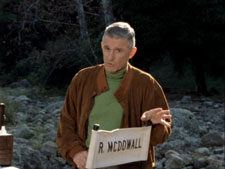
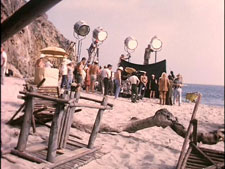
Disc #2 contains the rest of the special features directly related to the original film, most notably the definitive 1998 documentary Behind the Planet of the Apes. Hosted by Roddy McDowall, and clocking in at over two full hours, Behind lives up to its name and gives a wonderful look at so many of the details of the original film's production as well as sequels and hysteria that ensued. The first hour is almost entirely devoted to the original with the second hour focusing on the rest of the story. While you're unlikely to find a better television documentary on similar subject matter, Behind does focus a little to heavily on summarizing the events that occurred in the film instead of delving into even more background on its production, like the long line of leading men Jacobs tried to get before turning to Heston or how he parlayed his public relations contacts into casting most of the original film. Minor criticisms aside, this documentary is immensely entertaining and enjoyable to anyone from the casual viewer to the seasoned fan. Missing from the set, unfortunately, is the candid interview with Roddy McDowall that can be found on the original Behind the Planet of the Apes DVD release.
Also on Disc #2 is the famed original Makeup Test with Edward G. Robinson (9:27) in the role of Zaius alongside James Brolin and Linda Harrison as Cornelius and Zira respectively. Delivering dialogue from one of Serling's early scripts, it is a wonderful look at the initial formation of the Apes saga. Roddy McDowall includes just over 20 minutes of his personal Home Movies from his adventures on the set, and there are another 20 minutes of Dailies and Outtakes as well. Also included are a series of promotion pieces intended to sell the film including a 1967 N.A.T.O. Presentation (10:26), a 1968 Featurette (4:37), 1972's A Look Behind The Planet of the Apes (13:37), and over 16 minutes of Trailers. Much of this material is repeated in various forms, but it is interesting to take a look at if you are curious how Fox went about pitching the project to others, and there are a few scenes of Heston trying his best to sell it with charm.
Finally, there are two brief segments entitled Don Taylor Directs Escape from the Planet of the Apes (7:30) and J. Lee Thompson Directs Conquest of the Planet of the Apes (1:07). The former shows the director setting up a sequence involving Armando and his circus, while the latter gives an short glimpse at a chimpanzee's mask-fitting. Neither is particularly compelling. Rounding out the features are some slideshows of Original Sketches by Costume Designer Morton Haack, a Still Gallery of various pictures from the set, Ape Merchandise, and Ape Collections which shows some of the costume designs. If you're viewing the disc on your DVD-ROM, there is a small application that provides a graphic timeline and a few tidbits of trivia.
Aside from 7 pictures in a Photo Gallery on Disc #3 to accompany Beneath the Planet of the Apes, the only features on the four sequel films are a quick Cast overview, a set of repeated Theatrical Trailers, and an essentially worthless Web Link. Disc #10, the final disc of the live-action television series, contains two awkwardly placed trailers that are a carry-over from the previous DVD release. Planet of the Apes Cross Trailer is an ad for the "Evolution" box set, outmatched by the "Legacy" set and worthless to anyone who owns this 14-disc set. Planet of the Apes Theatrical Trailer is a 2-minute promotion for the 2001 film.
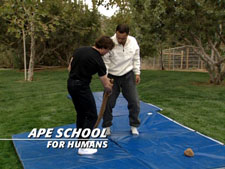
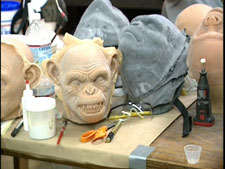
The remaining special features all apply to the reimagining, and they are truly an impressive bunch. I was so disgusted with the film when I first saw it in the theater that I never bothered to revisit it on DVD until now. I now see that I missed out on a wealth of interesting behind-the-scenes material and thoroughly enjoyed taking a look at it a few years removed from its original release. On Disc #13 are two more Audio Commentaries, but this time they are well worth a listen. The first is with Tim Burton, and he talks about every aspect of production. For as oddball as his films can be, he is very articulate, and it is easy to understand what he was going for with this film. Although the final result really missed the mark, I can understand where he was coming from with some of his decisions. He spends most of the final half-hour of the track trying to explain his way out of the film's finale, as if he knows everyone is sitting there listening to it with anger. Composer Danny Elfman provides the second commentary, and it is a combination of Elfman talking about the music and long stretches of isolated score. Film music has always fascinated me, and listening to Elfman outline his process for putting together this piece is both informative and entertaining.
Also included on Disc #13 is an Enhanced Viewing Mode that uses DVD branching to present little picture-in-picture videos during certain parts of the film as key members of the crew explain how a certain sequence was achieved. In some parts, the logo of the Oberon ship appears, and by selecting it you can view a short video that goes into even more detail of a particular scenes. Finally on this disc are Cast & Crew Profiles, which are mostly just textual information, but buried within them are the first auditions for Estella Warren (Daena), Erick Avari (Tival) and Luke Eberl (Birn). They're good for a laugh, particularly Warren's. If you pop it into a DVD-ROM, you can compare the script and storyboards against the actual feature.
Disc #14 contains the bulk of the features for the 2001 film, most in the form of featurettes. Simian Academy (24:08) follows Terry Notary's "Ape School", where the stars and extras were taught to act and think like apes in preparation for the film. Face Like a Monkey (29:43) features Rick Baker's impressive makeup designs and all the little things that went into their preparation. Ape Couture (6:31) details the costuming, Chimp Symphony Op. 37 (9:38) gives even more detail on the recording of Burton's score, On Location: Lake Powell (11:58) covers the desert shoot at one of the sites of the original film with some hilarious behind-the-scenes footage of Michael Clarke Duncan, and Swinging from the Trees tackles many of the wire-controlled ape stunts. Each of these is quite interesting whether you enjoyed the film or not.
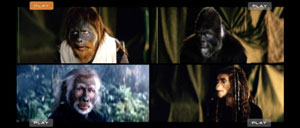
This final disc also contains a group of Screen Tests, uniquely presented with four simultaneous videos running in different quadrants of the screen and giving the user the option to decide which audio feed he would like to be active. Considering the often uninteresting nature of many of these tests, it's a perfect way to get the idea of all of it without getting bored. The five areas covered are Makeup (3:45), Costumes (1:34), Group (2:37), Stunts (4:13), and Movement (1:46). Each segment is short enough to be worth taking a look at, and they have been edited together in a way that the default audio feed is an interesting one. "Stunts" is a single video feed and is probably the most interesting of the group.
Delving further into the disc, there are 8 Multi-angle Featurettes that each take a scene from the film and show different audio and video feeds from the various perspectives being filmed at the same time. These segments give a glimpse into how a director blocks a shot before it is edited together into the final product. There are also 5 Extended Scenes that really don't add much of anything and are just slightly longer versions of what is already found in the film: Launch the Monkey (1:14), Dinner (1:18), Kill Them All (0:59), Ari in the Trees (0:43), and She's a Chimpanzee (0:55). An HBO special titled The Making of Planet of the Apes (26:41), hosted by Michael Clarke Duncan, is relatively interesting, although it does combine a lot of the material already seen in the other featurettes. Wrapping up the disc is the music video for Paul Oakenfeld's "Rule the Planet Remix" (2:56), a 30-second Music Promo for Elfman's soundtrack, a Still Image Gallery, and Trailers & TV Spots. Using a DVD-ROM device, you can see a worthless features called "Leo's Logbook" and read the first pages of the novel version of the film.
"Planet of the Apes - The Ultimate DVD Collection" is insanity. It is indulgent. It is overkill. And I love it. The original film is a classic of science fiction, a piece worthy of the reverence it still receives almost 40 years later, and while the sequels vary in their quality, it is always fun to revisit them and spend some time in the Apes universe. The television series really don't hold much rewatchability, but if you have never seen them before, they're worth a single viewing, particularly the live-action version. As for the reimagining, well, at least the special features are very engrossing. What makes this collection so unique, though, is the enormous Caesar bust packaging that is undeniably something to behold. It really is a special set for the Apes collector.
All that said, considering what is already available on the market with regard to these titles, if you purchase this collection, understand that you are essentially buying a giant ape head. Everything else except the animated series can be found elsewhere and much cheaper, and if you've read this review, you should know that the animated series isn't worth that much anyway, even if it is never released on its own in the future. However, if you've read this far, I suspect you don't particularly care. You just want the ape head, and I can't really blame you. Expensive or not, it certainly is awesome. Highly Recommended.
Included in the set is the following material:
Disc One - Planet of the Apes (1968)
Disc Two - Planet of the Apes (1968) - Special Features
Disc Three - Beneath the Planet of the Apes (1970)
Disc Four - Escape from the Planet of the Apes (1971)
Disc Five - Conquest of the Planet of the Apes (1972)
Disc Six - Battle for the Planet of the Apes (1973)
Disc Seven - Planet of the Apes (1974) (TV)
Disc Eight - Planet of the Apes (1974) (TV)
Disc Nine - Planet of the Apes (1974) (TV) |
Disc Ten - Planet of the Apes (1974) (TV)
Disc Eleven - Return to the Planet of the Apes (1975) (TV)
Disc Twelve - Return to the Planet of the Apes (1975) (TV)
Disc Thirteen - Planet of the Apes (2001)
Disc Fourteen - Planet of the Apes (2001) - Special Features |
|
| Popular Reviews |
| Sponsored Links |
|
|
| Sponsored Links |
|
|
| Release List | Reviews | Shop | Newsletter | Forum | DVD Giveaways | Blu-Ray | Advertise |
|
Copyright 2024 DVDTalk.com All Rights Reserved. Legal Info, Privacy Policy, Terms of Use,
Manage Preferences,
Your Privacy Choices | |||||||










